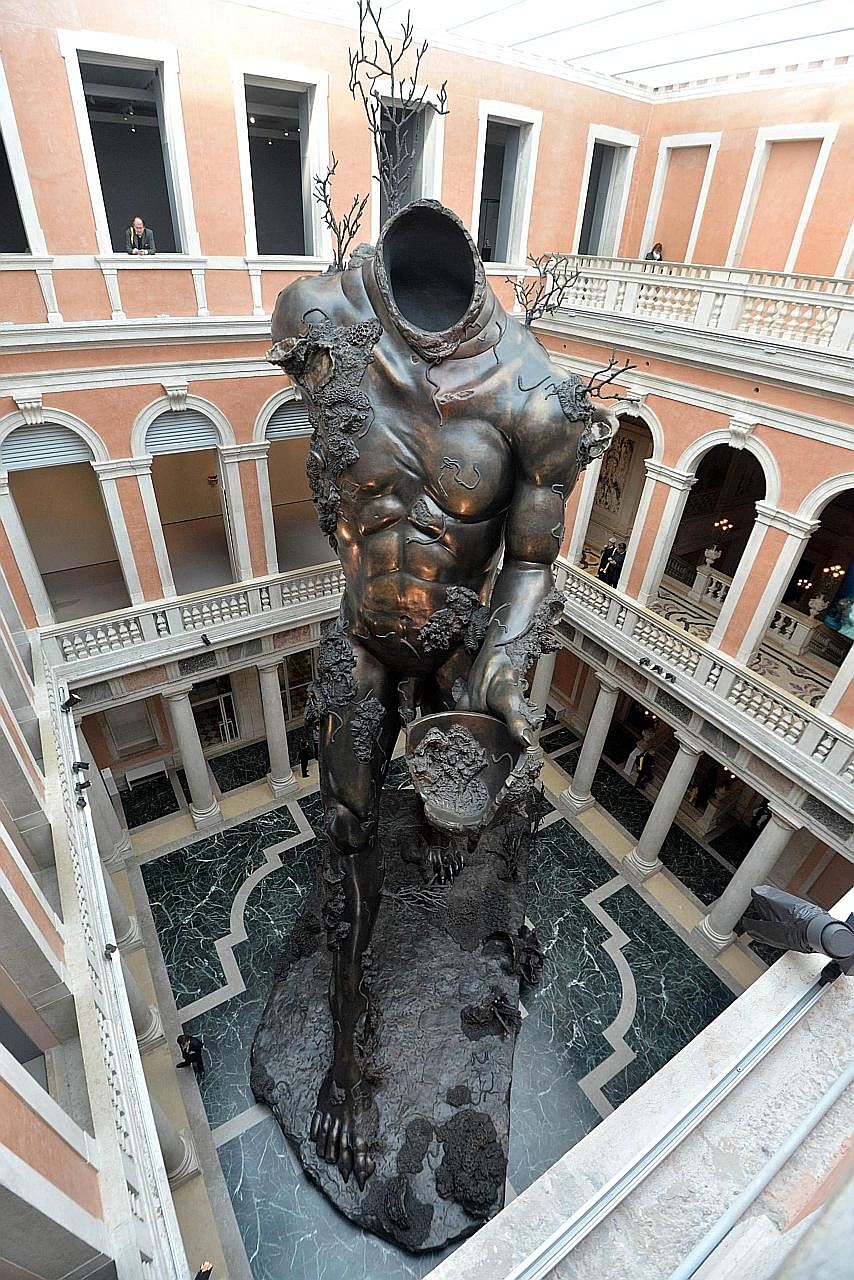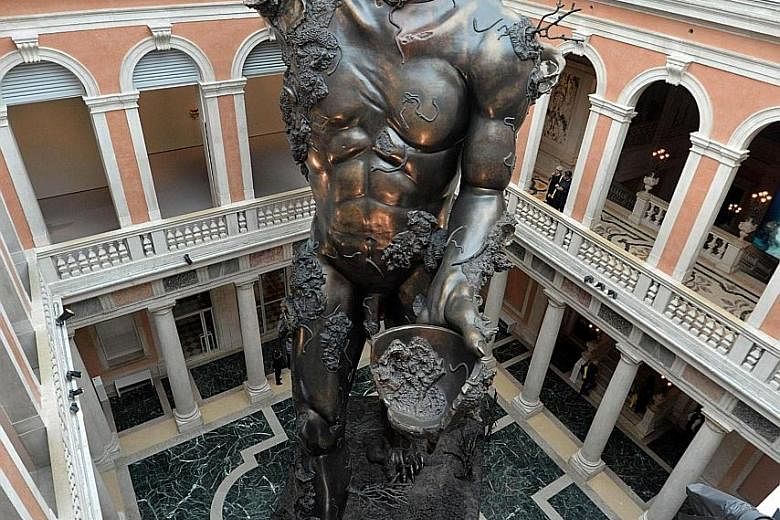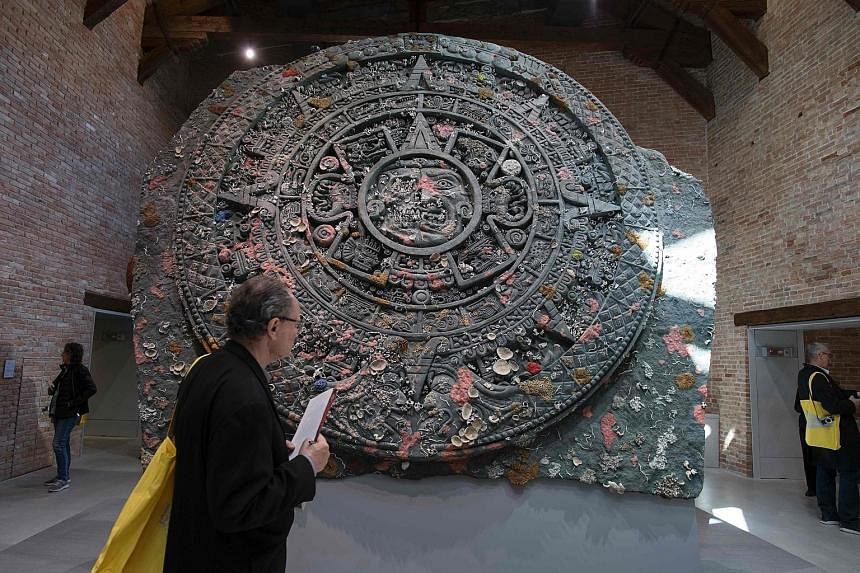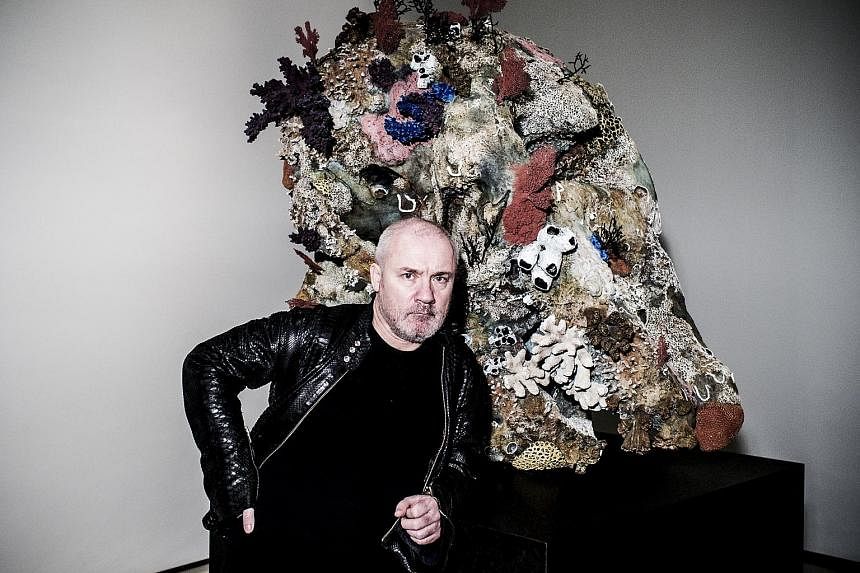VENICE • Damien Hirst is staring into the eyes of a jade Buddha, its face seemingly abraded by the vestiges of time.
"I think he looks good, considering he's 2,000 years old," the artist said, straining to keep a straight face.
Nearby, the sculpture of a pharaoh fashioned from blue granite and displaying a gold nipple ring bears an uncanny resemblance to Pharrell Williams.
Is the face really that of the singer? "You could say that," Hirst responded. "It's all about what you want to believe."
After years of uncharacteristic silence, the artist, known for his love-it-or-hate-it artworks, is orchestrating his comeback.

On a recent morning, dressed all in black, he could be found in the soaring entrance of the Palazzo Grassi watching his crew put the finishing touches on an extravaganza worthy of the late film-maker Cecil B. DeMille - his first major show of new work in more than 10 years.
Opening to the public yesterday and called Treasures From The Wreck Of The Unbelievable, it is an underwater fantasy, with sculptures such as the Buddha and hundreds of other objects fashioned to look as if they were antiquities dredged up from the bottom of the sea.
The works will fill the Palazzo Grassi and the Punta della Dogana, two museums run by Mr Francois Pinault, the Parisian collector who is also the owner of Christie's auction house.
This show is widely seen as Hirst's attempt, at 51, to kick-start his career, which has suffered since 2008, when the financial and art markets crashed. Tapping the age- old romance of shipwrecks, he and his patron are embarking on a giant artistic and financial gamble.
Treasures cost Hirst millions of dollars to produce and Mr Pinault millions to present (exact figures were not disclosed by either man). Collectors who have been offered the works report that prices start at about US$500,000 (S$700,000) a piece, rising to more than US$5 million.
With Hirst's market untested on such a grand scale, the question the art world is asking is: Will he sink or swim in Venice?
Mr Francesco Bonami, a curator who organised a major exhibition of Hirst's work in Doha, Qatar, four years ago, said the latest Hirst production "goes beyond good or bad", adding: "In his bombastic, exaggerated way, Damien has created a narrative the likes of which the public has never seen. Many will call it bad taste or kitsch, but it's more than all of that. It's Hollywood."
In keeping with Hirst's reputation as a serial shocker, Treasures presents a visual, believe-it-or-not fairy tale rooted in mythology, theology and the artist's imagination.
The story goes like this: In 2008, a shipwreck was discovered off the coast of East Africa that is said to have contained a stash of treasures belonging to Cif Amotan II, a freed slave from north-west Turkey who lived between the first and early second centuries and who had amassed great wealth. His legendary collection of art and artefacts was placed on a ship, the Unbelievable, which sank.
Divers rescued more than 100 works - giant sculptures of sea monsters encrusted with coral and semi-precious stones; golden monkeys, unicorns and tortoises; as well as a goddess whose face looks oddly like model Kate Moss, a marble pharaoh that resembles singer Rihanna and a bronze statue of Mickey Mouse, covered with centuries of marine decay.
None of the new works is unique. Each is made in an edition of three, with two artist's proofs. In each edition, there are three sculptures: what Hirst describes as the "Coral", meaning the work created to look like its "original" encrusted state from the deep; a "Treasure", the artwork seemingly restored by conservators for display; and the "Copy", which purports to be a modern museum reproduction of the original.
For nearly four months, Ms Elena Geuna, the show's curator, has been orchestrating the mammoth transport of sculptures - some weighing as much as 4 tonnes - by boat, many from a foundry in Gloucestershire, England, and installing videos and countless tiny objects that fill the show's nearly two dozen glass vitrines (each vitrine is considered one artwork).
All told, more than 1,000 suppliers from places such as Italy, Germany, South Africa and the United States were involved in making the show.
"It's like Elvis coming back to play in Las Vegas," said Mr Oliver Barker, chairman of Sotheby's Europe. "After more than a decade, Damien is once again allowing his work to be scrutinised by a large public and, in doing so, he is definitely putting his neck on the line."
Mr Barker has witnessed Hirst's gambles up close. In 2008, he helped mastermind the artist's audacious attempt at bypassing his dealers by organising an epic auction at Sotheby's of more than 200 of his works.
It took place on the same fateful day that Lehman Brothers, an investment bank, declared bankruptcy, yet Hirst still managed to sell US$200 million of his work.
Since then, his prices have wildly seesawed. While one of his Spot paintings sold in a Sotheby's sale in November for just US$396,500 - a steep decline from the US$1.7 million they sometimes commanded in 2013 - prices have been inching up.
White Cube, a gallery in London, claimed to have sold a 2015 painting by Hirst, Holbein (Artists' Watercolors), measuring 4m wide, priced at £750,000 (S$1.3 million), showing he could still sell at a reasonably high level.
The new work is a step up, with a severed head of Medusa said to be priced at US$4 million. With the contemporary art market showing signs of strengthening, Mr Barker called the prices "well moderated".
But the monumental scale of many works may make it difficult to sell to anyone who does not own a museum-sized house.
NYTIMES



